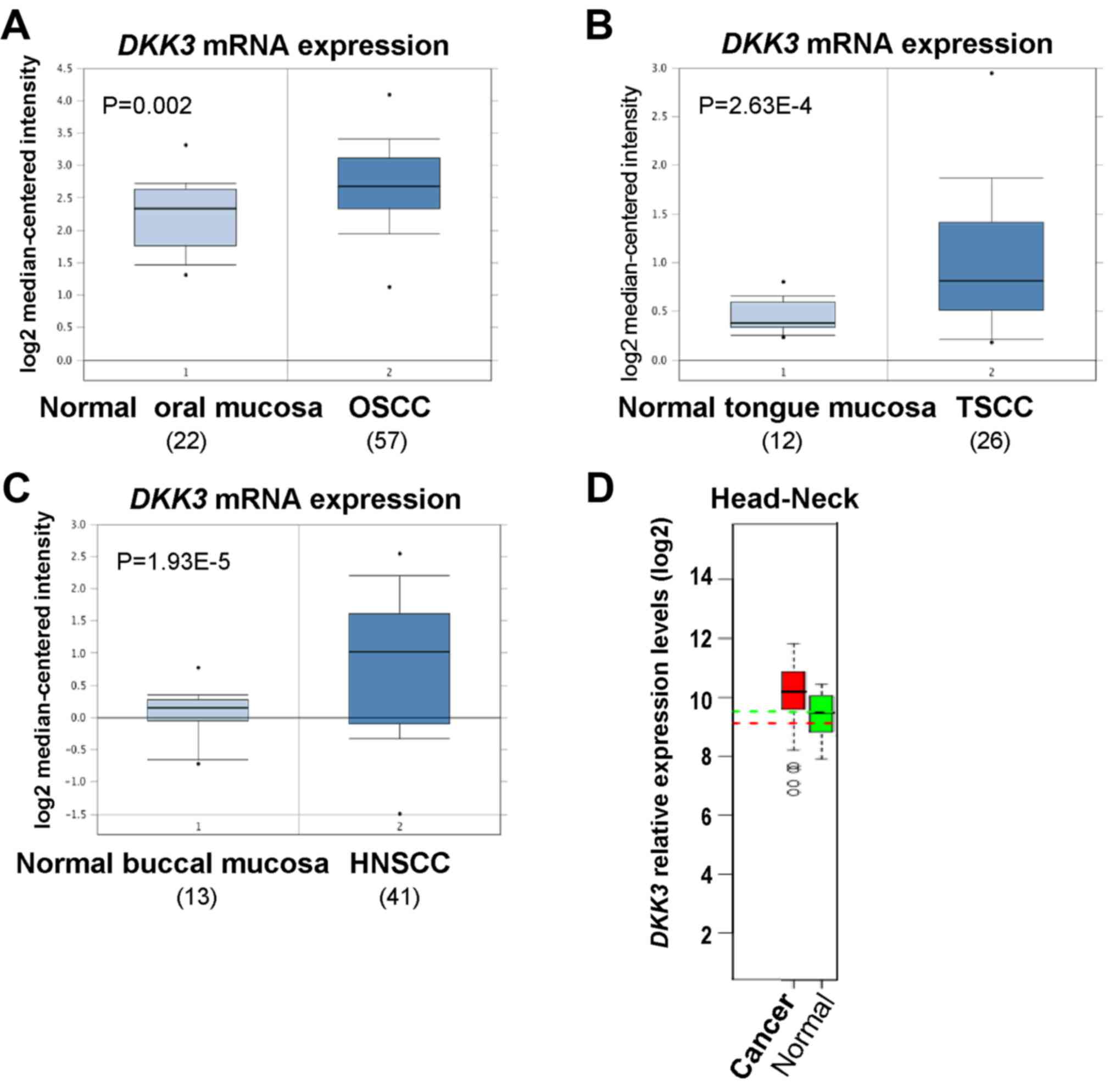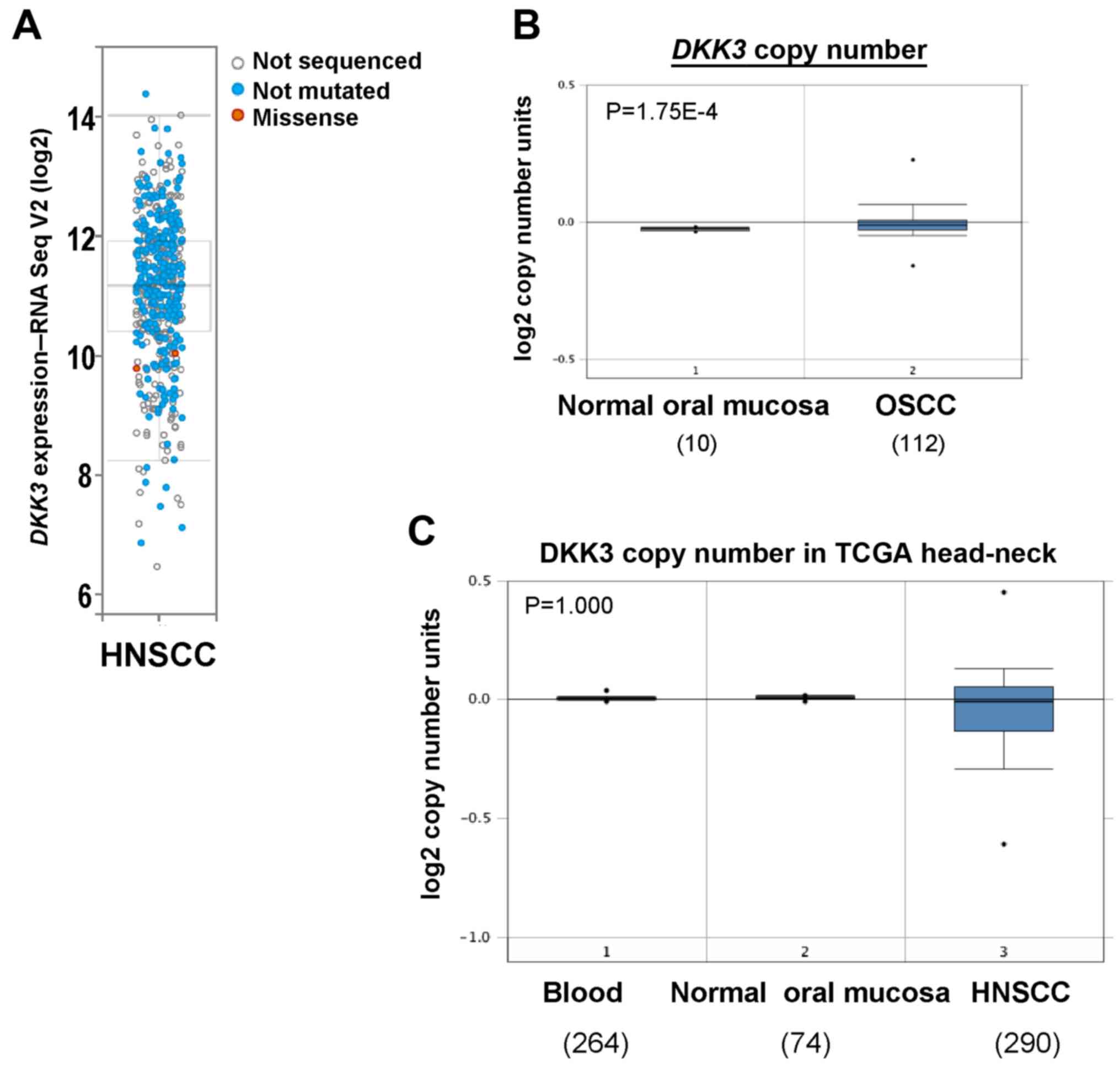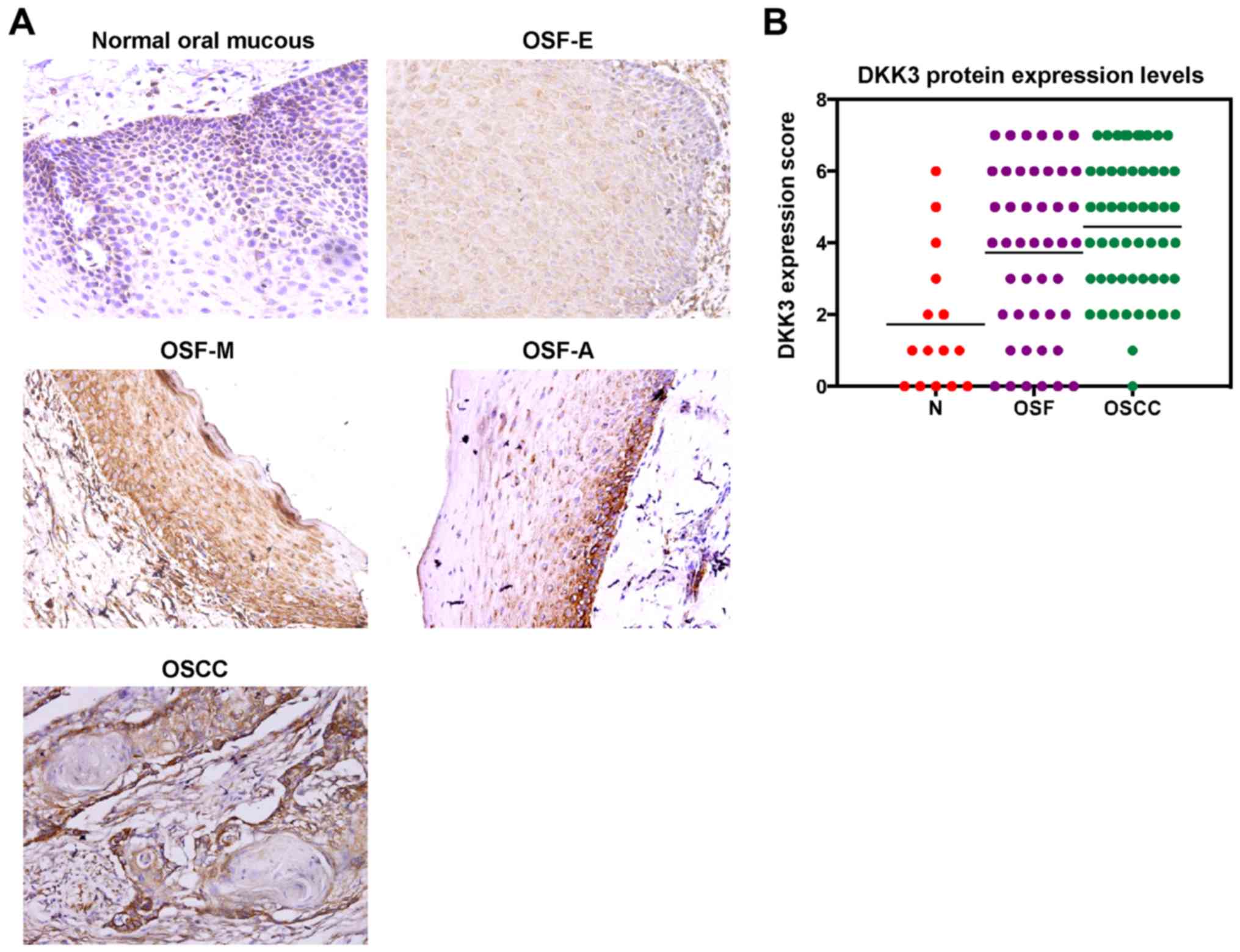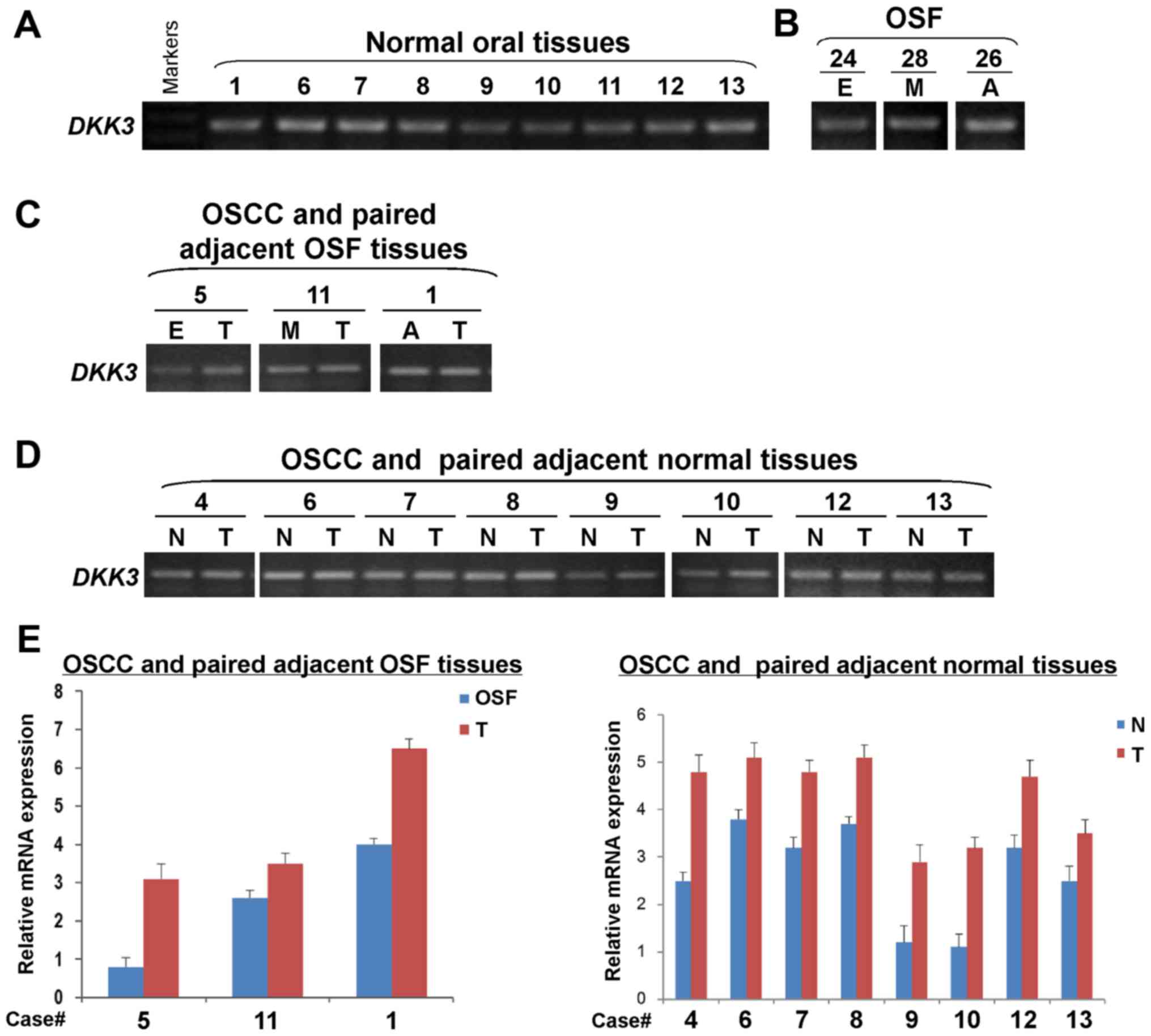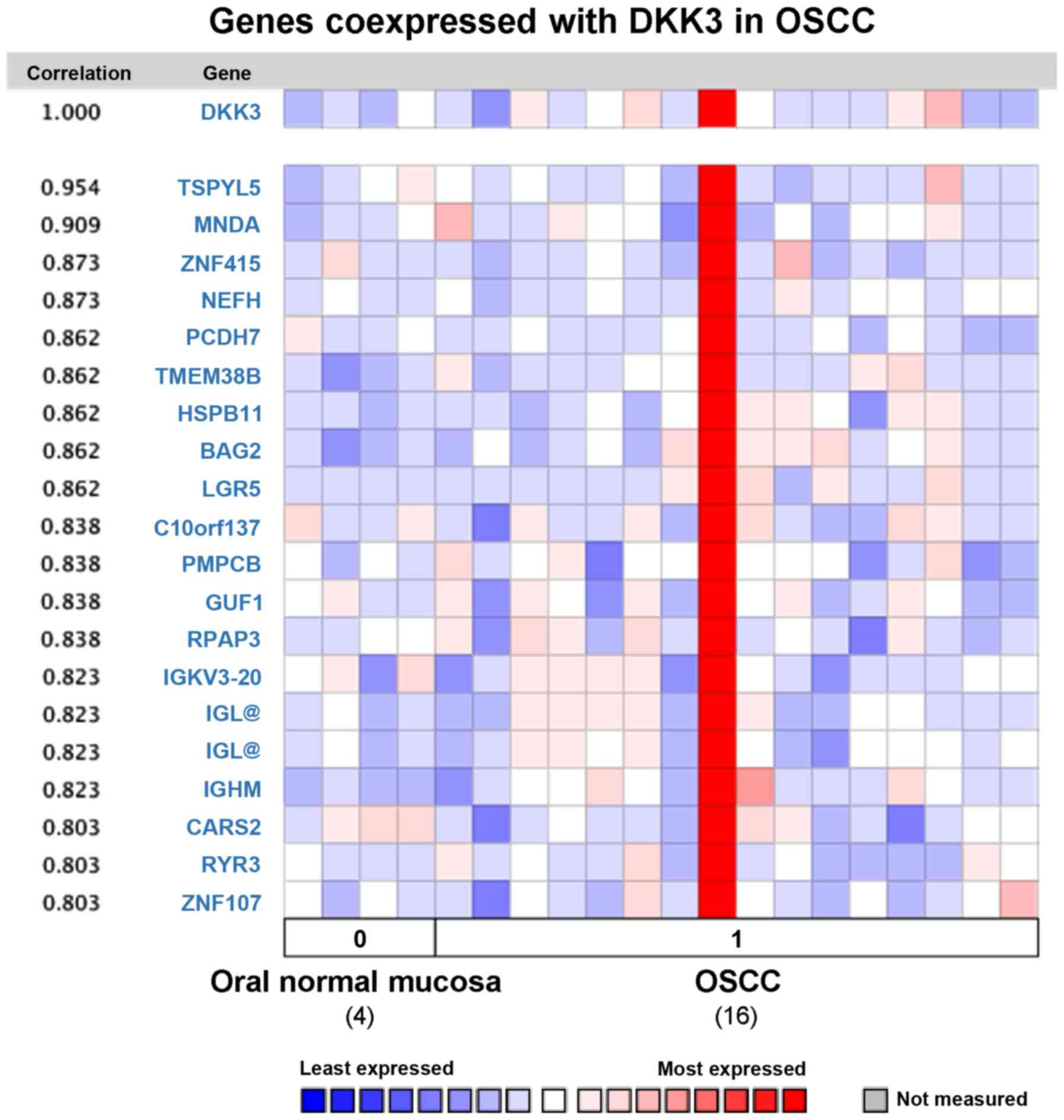Expression pattern of DKK3, dickkopf WNT signaling pathway inhibitor 3, in the malignant progression of oral submucous fibrosis
- Authors:
- Published online on: December 8, 2016 https://doi.org/10.3892/or.2016.5307
- Pages: 979-985
Abstract
Introduction
Oral squamous cell carcinoma (OSCC) constitutes more than 90% of all malignant neoplasms in the oral cavity, with an increased number of new OSCC cases worldwide and varied geographical distribution (1,2). OSCC is prevalent in Southern Asia and Latin America, and is the most common cancer among the male population (3,4). In the high-risk areas, betel quid (BQ) chewing, tobacco and alcohol consumption have been well documented as etiologic factors for OSCC (4,5). A causal relationship between BQ chewing and the high incidence of oral cancer has been established, particularly its correlation with early oral premalignancies such as oral submucous fibrosis (OSF) (6,7). Despite the recent rapid improvement in multimodality treatment, the overall 5-year survival rate of OSCC remains poor. Thus, elucidation of molecular events during OSCC development and progression is needed for the early detection and therapy of OSCC.
Overactivation of Wnt/β-catenin signaling has been identified in the tumorigenesis of multiple cancers including OSCC, and plays critical roles in cell proliferation, differentiation, adhesion and stemness (7,8). Wnt ligands, antagonists and mutations of APC and β-catenin have been well-defined for its activation. The dickkopf (DKK) family as Wnt antagonists, contains five members, DKK1, DKK2, DKK3, DKK4 and DKKL1, with different impacts on Wnt/β-catenin signaling (9,10). However, the underlying mechanisms remain elusive. Notably, the secreted Wnt antagonist dickkopf-related protein 3 (DKK3) is emerging as a crucial regulator of human cancers (9). DKK3 is frequently reduced by promoter methylation in multiple solid and hematological cancers, acting as a functional tumor suppressor by affecting apoptosis and proliferation. Re-introduction of DKK3 expression in cancer cells may ba a potential biomarker and effective therapeutic approach.
There are several contradictory studies of DKK3 in head and neck squamous cell carcinomas (HNSCC) and OSCC. Its tumor suppressive and oncogenic functions have been reported in OSCC (11–15). However, the expression pattern of DKK3 in the malignancy progression of OSF has not been addressed. In the present study, we examined DKK3 expression at the protein and mRNA levels in normal oral mucosa, OSF and OSCC tissues, as well as the correlation with clinicopathological features. We also analyzed its potential function in the pathogenesis of OSCC.
Materials and methods
Tissue specimens
OSCC (n=55), OSF (n=45), and normal oral mucosa (n=15) tissue specimens were obtained at the time of surgical resection at Xiangya Second Hospital and Xiangya Hospital, Central South University (Changsha, China) and Shanghai Ninth People's Hospital, Shanghai Jiaotong University School of Medicine (Shanghai, China) from January 2013 to June 2014. The patient informed consents were obtained under a protocol reviewed and approved by the Institutional Review Boards of the Xiangya School of Medicine or Shanghai Jiaotong University School of Medicine. The clinical diagnosis and pathologic stage of the OSF were determined in terms of the Pingborg criteria (16). OSCC was diagnosed according to the World Health Organization criteria of 2005. Fifteen normal specimens were obtained from healthy oral mucosa. Forty-five cases of OSF were incident, newly diagnosed without OSCC or neoplastic disease. OSF was classified into 3 grades: early stage (E, n=15), moderately advanced stage (M, n=15) and advanced stage (A, n=15). All collected tissues were divided into two parts, one of which was frozen immediately at −80°C after careful removal of the tumor mass, OSF tissue in the epithelium layer and grossly normal-looking epithelium, and the other part was fixed in 4% buffered formalin solution for pathologic diagnosis and immunohistochemical staining. Clinicopathologic staging of OSCC was determined by the TNM classification of the International Union Against Cancer in 2009. The results of the immunostained formalin-fixed, paraffin-embedded (FFPE) sections were evaluated separately by two pathologists (C.Z. and Z.Y. at the Department of Oral Pathology of the respective affiliate hospital).
Immunohistochemistry
Immunohistochemical staining was performed on 4-µm serial sections from FFPE specimens. After deparaffinization and hydration, the slides were treated with endogeneous peroxidase in 3% H2O2 for 20 min. The sections were then blocked for 30 min at 37°C with 1.5% blocking serum in phosphate-buffered saline (PBS) before reacting with DKK3 (1:100 dilution; #10365-1-AP; ProteinΤech) at 4°C in a moist chamber overnight. Negative control slides were duplicate sections in the absence of primary antibodies. For evaluating DKK3 expression, a scoring method was used. A mean percentage of positive cells was determined by the examination of 500 cells in at least 5 areas at a magnification of ×400. Cells were assigned to 1 of the 5 following categories according to the percentage of positive cells (PP): 0, <5%; 1, 5–24%; 2, 25–49%; 3, 50–75%; and 4, >75%. The intensity of the DKK3 staining (SI) was then scored as follows: 0, negative (−); 1, weak (+); 2, moderate (++); and 3, intense (+++). The final immunoreactive score (IRS = SI + PP) was as follows: -, 0 or 1; +, 2 or 3; ++, 4 or 5; and +++, 6 or 7. The stained tissues were scored blindly regarding clinical patient data. Statistical analyses were performed with SPSS 19.0 software. Statistical significance was evaluated by the Chi-square test (χ2). The significance level was set at 0.05.
Reverse-transcription polymerase chain reaction (RT-PCR)
TRIzol reagent (Invitrogen Life Technologies, Karlsruhe, Germany) was used to extract total RNAs. Reverse transcription polymerase chain reaction (RT-PCR) was performed using a kit from Promega (Madison, WI, USA). Real-time PCR was performed to detect DKK3 expression, according to the manufacturer's protocol (HT7500 system; Applied Biosystems). Primers for amplifying DKK3 mRNA sequences were synthesized as previously described. The 161-bp mRNA of DKK3 was amplified by PCR with forward primer, 5′-CACCCTCAATGAGATGTTCC and reverse primer, 5′-TGGTCTCATTGTGATAGCTG. GAPDH as a control for all the samples was shown in our previous studies (17,18). PCR amplification was performed with denaturation at 94°C for 30 sec, annealing at 55°C for 30 sec, and extension at 72°C for 30 sec in 32 cycles. The PCR products were visualized on 2% agarose gels under ultraviolet transillumination.
Results
Increased expression levels of DKK3 in OSCC and HNSCC
We firstly investigated DKK3 expression in OSCC and HNSCC using the open access cancer microarray database Oncomine (https://www.oncomine.org/resource/login.html). Through analysis of studies by Peng et al, Ye et al and Ginos et al, the results revealed that DKK3 expression at the mRNA level was 1.377-fold higher in OSCC than that in normal oral mucosa tissues (P=0.002) (19), 1.433-fold higher in tongue squamous cell carcinoma (TSCC) tissues than that in normal tongue mucosa tissues (P=2.63E-4) (20), 1.831-fold higher in HNSCC tissues than that in normal buccal mucosa (P=1.93E-5) (21) (Fig. 1A-C). By analyzing microarray data from the GENT dataset (http://medical-genome.kribb.re.kr/GENT/search/search.php), DKK3 was found to be overexpressed in HNSCC tissues, compared with the level in the corresponding normal oral mucosa tissues (Fig. 1D). These results suggest that DKK3 upregulation may play a crucial role in OSCC development.
Genetic alteration of DKK3 in OSCC
We next assessed genetic alterations of DKK3 in HNSCC including OSCC using The Cancer Genome Atlas (TCGA) database. DKK3 was overexpressed in two TCGA HNSCC cohorts, with a rare mutation (Fig. 2A). Copy number analysis using Oncomine database showed an increased DKK3 gene copy number in OSCC tissues (P=1.75E-4), compared with that noted in normal oral mucosa tissues (Fig. 2B). Although deletion of DKK3 was observed in the HNSCC TCGA cohort, there was no statistically significant difference (Fig. 2C). These results suggest that gain of DKK3 gene copy number may lead to increased DKK3 expression level in OSCC.
DKK3 upregulation at the protein level in the carcinogenesis of OSF
To evaluate DKK3 protein expression in malignant progression of OSF, we firstly performed immunohistochemical staining using a DKK3-specific antibody in normal oral mucous, OSF and OSCC tissues. Six of 15 (33.3%) normal oral mucous cases showed DKK3 positivity in the cytoplasm, and 35 of 45 (77.8%) OSF tissues showed cytoplasmic DKK3 expression, including tissues from 11 of 15 (73.3%) early stage, 12 of 15 (80.0%) moderately advanced stage and 12 of 15 (80.0%) advanced stage, as well as 53 of 55 (96.4%) OSCC (Fig. 3A). The average values of DKK3 expression varied in the different tissue samples, including the mean score of 1.73 in normal oral mucosa tissues, 3.73 in OSF tissues and 4.45 in OSCC tissues (Fig. 3B; Table I). DKK3 expression level was gradually increased in normal oral, OSF and OSCC tissues (P<0.05).
The correlation between DKK3 expression and the clinicopathological features of the OSCC cases was analyzed, including age, gender, tumor site, primary tumor, TNM stage and differentiation grade. DKK3 expression between male patients and female patients was statistically significant (Table II). These data suggest that DKK3 is upregulated at the protein level in the carcinogenesis of OSF.
DKK3 mRNA expression is elevated in the carcinogenesis of OSF
DKK3 expression at the mRNA level was examined in normal oral mucosa and OSF tissues, as well as OSCC and their paired adjacent tissues by semi-quantitative RT-PCR. We found that DKK3 was expressed in normal oral mucosa (Fig. 4A) and OSF tissues in different stages (Fig. 4B) with varied levels. DKK3 expression was detected in OSCC and their adjacent OSF tissues. Results showed that DKK3 expression levels were higher in OSCC tissues, than their adjacent OSF tissues (Fig. 4C). Moreover, the DKK3 expression level was upregulated in OSCC tissues, compared with the paired adjacent normal tissues (Fig. 4D). Increased mRNA expression level of DKK3 in OSCC tissues was further confirmed by real-time RT-PCR, compared with their adjacent normal or OSF tissues (Fig. 4E). Therefore, the DKK3 mRNA expression level is increased in the carcinogenesis of OSF.
Analysis of co-expressed genes with DKK3 in OSCC
To further investigate the potential function of DKK3 in OSCC, average linkage hierarchical clustering was applied to identify the co-expressed gene set with DKK3 in the Oncomine database. One study comparing DKK3 expression data for normal oral mucosa and OSCC tissues was selected for analysis, by using human genome U133A array with 12,624 genes measured. Nineteen genes were co-expressed with DKK3 in OSCC with correlation rate from 0.803 to 0.954 (Fig. 5): TSPYL5, MNDA, ZNF415, NEFH, PCDH7, TMEM38B, HSPB11, BAG2, LGR5, co10orf137, PMPCB, GUF1, RPAP3, IGKV3-20, IGL, IGHM, CARS2, RYR3 and ZNF107. Several of these genes are related to Wnt and p53 signaling, apoptosis, Ca2+ and mitochondrial signaling pathways.
Discussion
Cumulative genetic and epigenetic aberrations in cancer genes contribute to OSCC tumorigenesis. Thus, identification of key genes involved in OSCC initiation and progression, particularly malignant progression of precancerous OSF lesions, is vital. As one of the Wnt antagonists, DKK family members antagonize the Wnt signaling pathway by interacting with the Wnt co-receptors LRP5 and LRP6, further preventing their interaction with Wnt ligands (10,22,23). Unlike other family members, only DKK3 and DKKL1 contain sgy-domain thus are divergent members of the DKK family (10), suggesting possible Wnt-independent function of DKK3 other than as a Wnt antagonist in tumorigenesis.
DKK3 downregulation by promoter CpG methylation has been reported in multiple types of cancer, including thyroid (24), lung (25,26), gastric (27), colon (27), hepatocellular (27,28), breast (29,30), ovarian (31), cervical (32) and renal (33,34) cancers, as well as acute myeloid leukemia (35) and glioma (36). Various studies found that DKK3 is a putative Wnt signaling inhibitor. In OSCC, DKK3 possesses tumor-suppressive function or oncogenic function. DKK3 was found to be epigenetically inactivated in oral cancer, along with other Wnt antagonists WIF1 and SFRPs (12). DKK3 deletion was detected in HNSCC samples using Oncomine and TCGA databases, although no statistical significance and significantly prolonged overall survival were observed, suggesting that DKK3 may function as a tumor-suppressor gene (TSG) in OSCC. Recent studies provide strong evidence that DKK3 plays an oncogenic role in OSCC. DKK3 protein expression was found to be increased in dysplasia and further in OSCC, and was found to be correlated with OSCC metastasis and poor prognosis, independent of the Wnt signaling pathway (13–15).
In the present study, we found that DKK3 was statistically significantly upregulated in OSCC development by bioinformatic analysis. A rare genetic mutation of DKK3 was found in OSCC. DKK3 gene copy number was increased in OSCC, compared to normal oral mucosa, thus further causing DKK3 upregulation in OSCC. We also found that DKK3 either at the protein level or at the mRNA level was expressed in normal oral mucosal tissues, and the levels were gradually increased in the different stages of OSF and OSCC tissues with BQ chewing, which is consistent with other reports. By analyzing co-expressed genes with DKK3, potential biological functions and molecular mechanisms of DKK3 in OSCC pathogenesis were shown. For example, DKK3 activates the Wnt signaling pathway by binding to and activating LGR5 (37,38); DKK3 was found to inhibit the p53 signaling pathway by modulating TSPYL5 (39) and ZNF415 (40); DKK3 also suppressed apoptosis through the mitochondrial signaling pathway.
In summary, we provide evidence that the DKK3 expression level is increased in the carcinogenesis of OSF. DKK3 copy number gains are responsible for its upregulation in OSCC. The present study revealed the oncogenic role of DKK3 in the malignant progression of OSF, and sheds light on the development of a valuable tumor biomarker for the early detection of OSCC.
Acknowledgements
The present study was supported by the National Natural Science Foundation of China (no. 81202133) and the Cross Research Fund of Biomedical Engineering of Shanghai Jiaotong University (YG2016MS04).
References
|
Torre LA, Bray F, Siegel RL, Ferlay J, Lortet-Tieulent J and Jemal A: Global cancer statistics, 2012. CA Cancer J Clin. 65:87–108. 2015. View Article : Google Scholar : PubMed/NCBI | |
|
Braakhuis BJ, Brakenhoff RH and Leemans CR: Head and neck cancer: Molecular carcinogenesis. Ann Oncol. 16:(Suppl 2). ii249–ii250. 2005. View Article : Google Scholar : PubMed/NCBI | |
|
Leemans CR, Braakhuis BJ and Brakenhoff RH: The molecular biology of head and neck cancer. Nat Rev Cancer. 11:9–22. 2011. View Article : Google Scholar : PubMed/NCBI | |
|
Choi S and Myers JN: Molecular pathogenesis of oral squamous cell carcinoma: Implications for therapy. J Dent Res. 87:14–32. 2008. View Article : Google Scholar : PubMed/NCBI | |
|
Pindborg JJ, Murti PR, Bhonsle RB, Gupta PC, Daftary DK and Mehta FS: Oral submucous fibrosis as a precancerous condition. Scand J Dent Res. 92:224–229. 1984.PubMed/NCBI | |
|
Tilakaratne WM, Klinikowski MF, Saku T, Peters TJ and Warnakulasuriya S: Oral submucous fibrosis: Review on aetiology and pathogenesis. Oral Oncol. 42:561–568. 2006. View Article : Google Scholar : PubMed/NCBI | |
|
Wollina U, Verma SB, Ali FM and Patil K: Oral submucous fibrosis: An update. Clin Cosmet Investig Dermatol. 8:193–204. 2015. View Article : Google Scholar : PubMed/NCBI | |
|
Polakis P: Wnt signaling in cancer. Cold Spring Harb Perspect Biol. 4:42012. View Article : Google Scholar | |
|
Veeck J and Dahl E: Targeting the Wnt pathway in cancer: The emerging role of Dickkopf-3. Biochim Biophys Acta. 1825:18–28. 2012.PubMed/NCBI | |
|
Niehrs C: Function and biological roles of the Dickkopf family of Wnt modulators. Oncogene. 25:7469–7481. 2006. View Article : Google Scholar : PubMed/NCBI | |
|
Katase N, Gunduz M, Beder L, Gunduz E, Lefeuvre M, Hatipoglu OF, Borkosky SS, Tamamura R, Tominaga S, Yamanaka N, et al: Deletion at Dickkopf (dkk)-3 locus (11p15.2) is related with lower lymph node metastasis and better prognosis in head and neck squamous cell carcinomas. Oncol Res. 17:273–282. 2008. View Article : Google Scholar : PubMed/NCBI | |
|
Pannone G, Bufo P, Santoro A, Franco R, Aquino G, Longo F, Botti G, Serpico R, Cafarelli B, Abbruzzese A, et al: WNT pathway in oral cancer: Epigenetic inactivation of WNT-inhibitors. Oncol Rep. 24:1035–1041. 2010.PubMed/NCBI | |
|
Fujii M, Katase N, Lefeuvre M, Gunduz M, Buery RR, Tamamura R, Tsujigiwa H and Nagatsuka H: Dickkopf (Dkk)-3 and β-catenin expressions increased in the transition from normal oral mucosal to oral squamous cell carcinoma. J Mol Histol. 42:499–504. 2011. View Article : Google Scholar : PubMed/NCBI | |
|
Kataoka K, Du G, Maehara N, Murata H, Sakaguchi M and Huh N: Expression pattern of REIC/Dkk-3 in mouse squamous epithelia. Clin Exp Dermatol. 37:428–431. 2012. View Article : Google Scholar : PubMed/NCBI | |
|
Katase N, Lefeuvre M, Tsujigiwa H, Fujii M, Ito S, Tamamura R, Buery RR, Gunduz M and Nagatsuka H: Knockdown of Dkk-3 decreases cancer cell migration and invasion independently of the Wnt pathways in oral squamous cell carcinoma-derived cells. Oncol Rep. 29:1349–1355. 2013.PubMed/NCBI | |
|
Gupta PC, Sinor PN, Bhonsle RB, Pawar VS and Mehta HC: Oral submucous fibrosis in India: A new epidemic? Natl Med J India. 11:113–116. 1998.PubMed/NCBI | |
|
Zhou S, Chen L, Mashrah M, Zhu Y, He Z, Hu Y, Xiang T, Yao Z, Guo F and Zhang C: Expression and promoter methylation of Wnt inhibitory factor-1 in the development of oral submucous fibrosis. Oncol Rep. 34:2636–2642. 2015.PubMed/NCBI | |
|
Zhou S, Chen L, Mashrah M, Zhu Y, Liu J, Yang X, He Z, Wang L, Xiang T, Yao Z, et al: Deregulation of secreted frizzled-related proteins is associated with aberrant β-catenin activation in the carcinogenesis of oral submucous fibrosis. Onco Targets Ther. 8:2923–2931. 2015. View Article : Google Scholar : PubMed/NCBI | |
|
Peng CH, Liao CT, Peng SC, Chen YJ, Cheng AJ, Juang JL, Tsai CY, Chen TC, Chuang YJ, Tang CY, et al: A novel molecular signature identified by systems genetics approach predicts prognosis in oral squamous cell carcinoma. PLoS One. 6:e234522011. View Article : Google Scholar : PubMed/NCBI | |
|
Ye H, Yu T, Temam S, Ziober BL, Wang J, Schwartz JL, Mao L, Wong DT and Zhou X: Transcriptomic dissection of tongue squamous cell carcinoma. BMC Genomics. 9:692008. View Article : Google Scholar : PubMed/NCBI | |
|
Ginos MA, Page GP, Michalowicz BS, Patel KJ, Volker SE, Pambuccian SE, Ondrey FG, Adams GL and Gaffney PM: Identification of a gene expression signature associated with recurrent disease in squamous cell carcinoma of the head and neck. Cancer Res. 64:55–63. 2004. View Article : Google Scholar : PubMed/NCBI | |
|
Holmen SL, Robertson SA, Zylstra CR and Williams BO: Wnt-independent activation of beta-catenin mediated by a Dkk1-Fz5 fusion protein. Biochem Biophys Res Commun. 328:533–539. 2005. View Article : Google Scholar : PubMed/NCBI | |
|
Fujii Y, Hoshino T and Kumon H: Molecular simulation analysis of the structure complex of C2 domains of DKK family members and β-propeller domains of LRP5/6: Explaining why DKK3 does not bind to LRP5/6. Acta Med Okayama. 68:63–78. 2014.PubMed/NCBI | |
|
Yin DT, Wu W, Li M, Wang QE, Li H, Wang Y, Tang Y and Xing M: DKK3 is a potential tumor suppressor gene in papillary thyroid carcinoma. Endocr Relat Cancer. 20:507–514. 2013. View Article : Google Scholar : PubMed/NCBI | |
|
Jung IL, Kang HJ, Kim KC and Kim IG: Knockdown of the Dickkopf 3 gene induces apoptosis in a lung adenocarcinoma. Int J Mol Med. 26:33–38. 2010.PubMed/NCBI | |
|
Kobayashi K, Ouchida M, Tsuji T, Hanafusa H, Miyazaki M, Namba M, Shimizu N and Shimizu K: Reduced expression of the REIC/Dkk-3 gene by promoter-hypermethylation in human tumor cells. Gene. 282:151–158. 2002. View Article : Google Scholar : PubMed/NCBI | |
|
Sato H, Suzuki H, Toyota M, Nojima M, Maruyama R, Sasaki S, Takagi H, Sogabe Y, Sasaki Y, Idogawa M, et al: Frequent epigenetic inactivation of DICKKOPF family genes in human gastrointestinal tumors. Carcinogenesis. 28:2459–2466. 2007. View Article : Google Scholar : PubMed/NCBI | |
|
Liang L, He H, Lv R, Zhang M, Huang H, An Z and Li S: Preliminary mechanism on the methylation modification of Dkk-1 and Dkk-3 in hepatocellular carcinoma. Tumour Biol. 36:1245–1250. 2015. View Article : Google Scholar : PubMed/NCBI | |
|
Veeck J, Bektas N, Hartmann A, Kristiansen G, Heindrichs U, Knüchel R and Dahl E: Wnt signalling in human breast cancer: Expression of the putative Wnt inhibitor Dickkopf-3 (DKK3) is frequently suppressed by promoter hypermethylation in mammary tumours. Breast Cancer Res. 10:R822008. View Article : Google Scholar : PubMed/NCBI | |
|
Xiang T, Li L, Yin X, Zhong L, Peng W, Qiu Z, Ren G and Tao Q: Epigenetic silencing of the WNT antagonist Dickkopf 3 disrupts normal Wnt/β-catenin signalling and apoptosis regulation in breast cancer cells. J Cell Mol Med. 17:1236–1246. 2013. View Article : Google Scholar : PubMed/NCBI | |
|
You A, Fokas E, Wang LF, He H, Kleb B, Niederacher D, Engenhart-Cabillic R and An HX: Expression of the Wnt antagonist DKK3 is frequently suppressed in sporadic epithelial ovarian cancer. J Cancer Res Clin Oncol. 137:621–627. 2011. View Article : Google Scholar : PubMed/NCBI | |
|
Lee EJ, Jo M, Rho SB, Park K, Yoo YN, Park J, Chae M, Zhang W and Lee JH: Dkk3, downregulated in cervical cancer, functions as a negative regulator of beta-catenin. Int J Cancer. 124:287–297. 2009. View Article : Google Scholar : PubMed/NCBI | |
|
Kurose K, Sakaguchi M, Nasu Y, Ebara S, Kaku H, Kariyama R, Arao Y, Miyazaki M, Tsushima T, Namba M, et al: Decreased expression of REIC/Dkk-3 in human renal clear cell carcinoma. J Urol. 171:1314–1318. 2004. View Article : Google Scholar : PubMed/NCBI | |
|
Ueno K, Hirata H, Majid S, Chen Y, Zaman MS, Tabatabai ZL, Hinoda Y and Dahiya R: Wnt antagonist DICKKOPF-3 (Dkk-3) induces apoptosis in human renal cell carcinoma. Mol Carcinog. 50:449–457. 2011. View Article : Google Scholar : PubMed/NCBI | |
|
Valencia A, Román-Gómez J, Cervera J, Such E, Barragán E, Bolufer P, Moscardó F, Sanz GF and Sanz MA: Wnt signaling pathway is epigenetically regulated by methylation of Wnt antagonists in acute myeloid leukemia. Leukemia. 23:1658–1666. 2009. View Article : Google Scholar : PubMed/NCBI | |
|
Mizobuchi Y, Matsuzaki K, Kuwayama K, Kitazato K, Mure H, Kageji T and Nagahiro S: REIC/Dkk-3 induces cell death in human malignant glioma. Neuro Oncol. 10:244–253. 2008. View Article : Google Scholar : PubMed/NCBI | |
|
Carmon KS, Lin Q, Gong X, Thomas A and Liu Q: LGR5 interacts and cointernalizes with Wnt receptors to modulate Wnt/β-catenin signaling. Mol Cell Biol. 32:2054–2064. 2012. View Article : Google Scholar : PubMed/NCBI | |
|
de Lau W, Barker N, Low TY, Koo BK, Li VS, Teunissen H, Kujala P, Haegebarth A, Peters PJ, van de Wetering M, et al: Lgr5 homologues associate with Wnt receptors and mediate R-spondin signalling. Nature. 476:293–297. 2011. View Article : Google Scholar : PubMed/NCBI | |
|
Epping MT, Meijer LA, Krijgsman O, Bos JL, Pandolfi PP and Bernards R: TSPYL5 suppresses p53 levels and function by physical interaction with USP7. Nat Cell Biol. 13:102–108. 2011. View Article : Google Scholar : PubMed/NCBI | |
|
Cheng Y, Wang Y, Li Y, Deng Y, Hu J, Mo X, Li N, Li Y, Luo N, Yuan W, et al: A novel human gene ZNF415 with five isoforms inhibits AP-1- and p53-mediated transcriptional activity. Biochem Biophys Res Commun. 351:33–39. 2006. View Article : Google Scholar : PubMed/NCBI |



